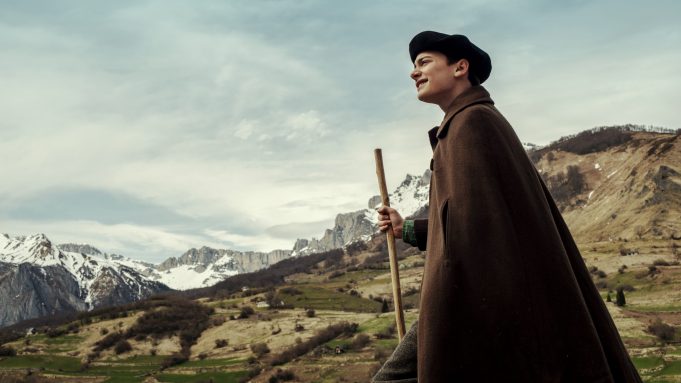Based on the children’s novel of the same name by “War Horse” author Michael Morpurgo, “Waiting for Anya” (2020) tells the story of Jo (Noah Schnapp from Stranger Things), a young shepherd living in a remote village in the south of France in 1942. His father is a prisoner of war and his mother and grandfather are sheep farmers. After an upsetting metaphoric incident with a mother bear Jo discovers a Jewish man called Benjamin (Frederick Schmidt) hiding out with a local widow Horcada (Anjelica Huston). Together they are smuggling children through the mountains into Spain. Jo helps by fetching food and warning of the comings and goings of German soldiers in their occupied village. With an increasing number of children under their care, one final daring escape is planned. The grandmother of the French New Wave, director Agnes Varda, speaks briefly about women smuggling children to safety in her film “The Beaches of Agnes” (2008). While she was on Girl Guide camp the leaders would take small groups away on special excursions as the others stayed behind. Later she came to understand these were girls being smuggled through the hills and across the border by the Guide leaders. In the context of war films mostly being about male soldiers on the front line (because that’s ‘where the action is’) while women risking their lives and exercising incredible bravery in other forms don’t get their stories told, I was looking forward to a wartime film with something different to say. But as the gruff French accented narrator who bookended the film introduced the story of “my village”, “my world”, and “how I became a man” I was crestfallen. It just felt like a missed opportunity. Especially as this is a very educational film clearly designed to help younger people understand this specific aspect of war. None of the 4 women spoke to each other and every brave or physical act was done by men and boys. The filmmakers chose some outstandingly beautiful places to film in the mountains. Great snow-capped peaks swirl in the mist and tower over luscious green fields. The hills and valleys were incredibly beautiful and the use of drone footage helped to showcase their magnificence. It contrasted well with the grey uniformed military forces occupying the village and the violent disruptive force they represented. There was also a parallel between the protection and herding of the sheep and the Jews shown in the opening scene being herded onto the Holocaust trains. The score is fairly heavy handed in its enhancement of the action in the scenes. There are clear ‘danger’ tones to the low strings, ‘tiptoe’ pizzicato and swelling bright moments. To me it was slightly too much but when you consider it as an educational film I imagine it would help younger viewers to understand each scene. In the same vein the acting was fairly over pronounced. If I was trying to sneak away from someone I wouldn’t give them a nervous looking side-eye the entire time. But again, it does make people’s intentions and emotions clearer for younger audiences. Each character was specifically defined in their roles. If you are looking to help children to understand themes like wartime refugees, how WWII impacted villages around Europe, and what it might be like to be separated from your family then this is a good start. It is a straight forward story to grasp and there is no terror or gore (although sensitive souls like myself will have to close their eyes during the bear scenes). A good companion for “The Railway Children” (1970), show it in schools or watch it with your children and be prepared to discuss it with them afterwards to make the most out of its messages. Comments are closed.
|
AuthorHi, I'm Caz. I live in Edinburgh and I watch a lot of films. My reviews focus mainly on women in film - female directors or how women are represented on screen. Archives
December 2021
Categories
All
|






 RSS Feed
RSS Feed
